Rome … Easy Going Crazy
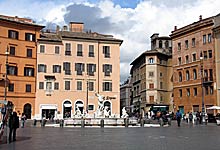
Piazza Navona
Rome Italy (sorry Rome, New York) is one of the top tourist destinations of all time. Like Paris, you can knock yourself out with the number of museums. Even more so than Paris, you can see enough cathedrals in one day to need resuscitation from the Vatican Swiss Guard. Like Paris, the traffic can (and might if you aren’t careful) kill you outright. But with all of the “colossal” sights to be seen in Rome, it remains a city with a soul and a city that can be downright pleasant to wander through. In fact, from within the historic center of the city, walking from the Spanish Steps to St. Peters Cathedral is hardly a significant effort unless it is very hot.
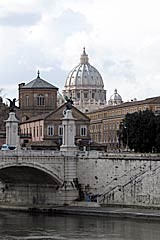
St. Peters Cathedral
One of the traveling conundrums that we find ourselves pondering when writing about a large city such a Rome is why people feel the need to “see everything” in a whirlwind tourist attraction-fest. It is most curious because it seems like such a very tiring and monotonous crusade. Might it be that many Americans feel they have to really “do” Rome once because they don’t ever expect to come back? What a shame because this is how great cities remain great … they age well, in time as well as in metaphor. Quite by accident at first, but now by design, I have determined not to visit Rome with the idea of pushing to see more but rather to make sure to include enough time to revisit that which I have enjoyed from a previous visit. Since Rome is one of the few Italian cities that international flights arrive to, it is easy to plan a night or two in Rome when arriving with plans to travel elsewhere, or to return to Rome a few days in advance of a scheduled departure home.
Whether you are Catholic or not, Christian or not, religious or not … St. Peters and at least the Sistine Chapel are incredible. The Coliseum as well as all of “old Rome” is very impressive. But if you make yourself too tired for a casual stroll through Piazza Navona in the afternoon or a visit to the Trevi Fountain at night you’ll miss a more casual feeling of Rome and probably won’t remember all of the marble busts you saw anyway. Do yourself a big favor and slow down. A successful visit to a great city should end on a feeling that you absolutely must return again soon.
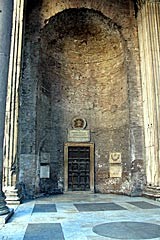
The Pantheon
The city of Rome, unlike say New York, has never given me a sense of panic or pressure except when riding with a select few of the Roman cab drivers. Some of the cabbies have been warm and conversational but others are downright crazy with a rushing death wish that exceeds any I have seen elsewhere. The last Roman cab ride we took to the train station from our hotel was an intense experience. The driver was maybe in his early 60’s and we were NOT in a rush. After honking and “driving herd” on pedestrians with his front bumper through a narrow alley he forced some poor guy on a small motorino into oncoming traffic. When the startled rider recovered his composure, after the bus and a truck screamed by, he stopped to curse at our driver at the next stop light but was basically called an “ass hole head” and left in the dust as soon as the light changed. Finally we approached the Rome Termini train station where an old lady on crutches could be seen nearing the edge of the road up ahead. Oh no … we both thought simultaneously and exchanged a horrified glance … he’s going to run her down for sure! It was all happening too fast to react and he was still accelerating. There was a screeching tire sound and a swerving braking motion that slid us over on the back seat towards the left door with bags and money in hand trying to escape our clutches as the old lady’s rear end just barely managed to escape the front fender. Of course he cursed something at her too, maybe for being so slow with those stupid crutches. This guy had a real anger management issue. The old lady just gave him a disinterested look and hobbled along.
But then, I have not yet driven in Naples where it is said that the traffic lights are “just a suggestion.”
I have since driven in the Naples area and can confirm that people there appear to become slightly suicidal when in close proximity to a piston engine. Especially when sitting on the engine as with a motorcycle or motorino.
And sadly, the flower vendor in the square below the Spanish Steps has been replaced with a tourist junk shop. The lights are over-bright harsh-white, perhaps LED bulbs, with absolutely no aesthetic value whatsoever and the walk through there has temporarily been damaged.
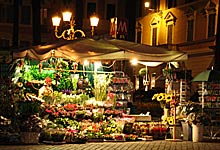
Below the Spanish Steps
There is nothing I enjoy more than a nighttime stroll through an old city that illuminates itself well and contains so many places worthy of illumination. Compare the little flower stand near the base of The Spanish Steps to a WallMart parking lot. You have to drag me away from the former but only kicking and screaming into the latter. Rome at night is a pleasing city and it is not only tourists that fill the streets and some of the well known landmarks. A good crowd of young Romans can often be found at the Trevi Fountain, perhaps making certain that their spectacular fountain remains owned by the inhabitants and not just the visitors.
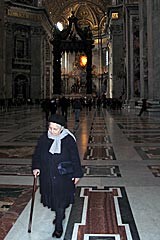
Inside St. Peters
When a special landmark building is unavailable for viewing due to ongoing restoration, it is not uncommon for an outer fabric covering to be printed that shows what the building actually looks like behind the temporary exoskeleton of scaffolding. Doing this (in full scale) must be an expensive component of the whole process but is a very welcome feature. Of course it is most impressive to see how many buildings are undergoing restoration though the need for it and rather desperate condition of many of the oldest landmarks is no doubt accelerated by the smog of the busy city traffic. Only once have I seen a billboard placed on such a restoration project though unfortunately that was in front of the facade of the famous Trinità Dei Monti at the top of the Spanish Steps. Hopefully this does not foretell a trend because the Italians are not yet as overrun with large billboard advertising as we are in the United States. Even if you cannot have every view and vista intact when you are in Rome (and other cities such as Venice), it is very nice to see that a concern for what you do see has been attended to.
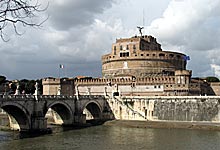
Castel S. Angelo
Rome is a city that is easily overtaken by its’ own imagery because that is one thing Rome, and Italians in general, are so damn good at. Federico Fellini was a master at conveying his odd and often maddening images through film. One way to prepare for a trip to Rome is to watch a few Fellini films. The grand nature of many of the sights in Rome need the perspective of people’s faces, sounds of the language and body gestures. An ability to grasp some of the more gruesome imagery that is cast, painted and carved into the many artifacts to be seen around the city is helpful too. The day to day Roman world contains likenesses of demons, death and despair as well as beauty, grace and elegance. The popular Dan Brown book, Angels and Demons, capitalized well on this dichotomy, building a dark murderous fiction on top of real history and places that exist today. To a great extent, his writing sheds fresh interest on old landmarks and their history. The Castel S. Angelo is most unlikely to house an Illuminati assassin because it is open to the public as a museum. But, it does have an escape route for the Pope by way of an old aqueduct from the Vatican.
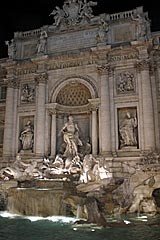
Trevi Fountain
So when visiting Rome you have a few basic choices. Get dragged around the city in a big ugly bus that stops everywhere just long enough that you can tell your friends back home “oh yeah, we did the such and such”.
Or, take your time to wander. Study up a bit before and while you explore. Finding a wonderful little square that isn’t featured in the guide book can be a great deal of fun.




